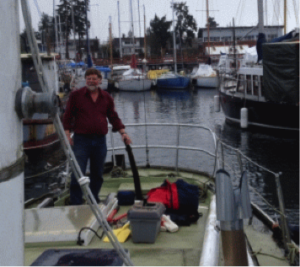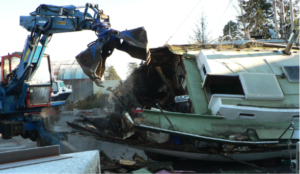Guest Blog by Graham Chamberlain and Barb Hardy
In January 1993, up in Genoa Bay, we bought a twenty year old 37 foot ferro cement sailboat from John Sampson. We circumnavigated Vancouver Island that year, and then for a number of years averaged 100 nights onboard up the outside coast north of Tofino. We wintered in the Sea of Cortes 96/97 and then lived on and off the boat in Comox & Tsehum Harbour through till 2008. Though the engine had died in Mexico, and we had removed the old Atomic, we had successfully sailed up through Arran Rapids and north with a small 5hp on the stern. Ashore 2008, after 6 great weeks in the San Juan’s, we became overwhelmed caring for a 100 year old heritage house in Victoria. On the cement-hulled boat the wood decks leaked, mold set in and 3 weeks painting, cleaning and a refit in the summer of 2011 gave us only 10 days at a can in Sidney Spit.
I turned 60 in early 2013, and with bad arthritis, we bought a wonderfully maintained 30 year old Campion 310 trawler. Two happy summers up the Broughton’s, Barkley Sound etc and we knew we would never use our sailboat again. And the mushrooms on the ferro-cement sailboat were taking over. What to do?
Sinking her seemed un-ethical – no fuel tanks or engine, but lots of wood, deck-head insulation from Mexico, arborite, wiring etc would float off and be a hazard. We had a ton of offers of those wanting to use her as a “live-aboard”. Fireplace, gimballed oven, water-maker, spacious and for free – but with a broomstick up her shaft tube few have the skill today to sail 11 tons without any reverse shifter – so she would probably have ended up a derelict sinking in some small bay.
So we binned her.
I’ll be honest around the costs, as that is what everyone questions us on. I’m not sure we did this the best or cheapest way, but I’ve 40 year’s boating and shipyard experience along this coast and it made sense to me. We didn’t ask for quotes for each stage, or dicker – we just paid what was invoiced.
- We stripped the boat of the main valuables – gimballed oven, diesel stove, winches, anchor, mast, windlass and put them on Used Victoria – $2200 back from quick sales….
- It cost $600 for the mast to be removed….
- We paid a local shipyard $800 for haul-out and the 5 days waiting to get her binned…
- We paid $1700 for a bin, trucking and fees at the dump for the 7.5 tons of remaining rubble, and
- We paid a friend $775 with a jaws-of-death “Spyder” back-hoe thingie to crush and twist the boat for 2 hours and chuck it all in the bin (sinks, stanchions, head, water tanks, a significant cement keel and hull).
We had stripped the boat in June 2014, gone travelling, and then late November co-ordinated the mast removal, crushing and disposal in less than a week (start to finish). Wow!
It was emotional to see a boat we had lived on, raised our girls on, grounded, had fires onboard, etc etc (as all boater yarns go), being crushed in chunks as if some tyrannosaurus was attacking the TWO of US. But we feel a monkey is now off our backs, that our loved boat will not blight our gorgeous coastline as some derelict, and that we have done the right thing – and can now move on.
Thank you to those that had patience as we came to this decision, and helped us as we did it! And to all the old salts that sauntered by proffering free advice and offers to help us selectively remove parts they saw of value. We fondly remember our gleaning various “treasures of the bilges” offered on VHF each morning on the cruisers net in the Baja.
We are off to Alaska April-October 2015 on our “new” (30 year old) trawler.
Cheers!
Graham
gbc53@telus.net




Good work recycling the old girl. A couple thousand bucks after parts sales sounds like a reasonable expense after so many years of good service, and a great investment in keeping our coastal waters free of #derelictvessels. Thanks, this is a good news story!
Thanks for the feedback, Water. It really is a wonderful, good news story! We will make sure that Barb and Graham see your comment.
Why not give it to someone who could afford to repower it? What a waste..I could afford an engine but not a boat, would love to sail before I die, not likely now..
Thanks for the comment W. Whitla. The authors are really the only ones in a position to judge whether the boat was worth saving. Boats are never free, and often those who take on ‘free’ boats are unaware of the incredible commitment and cost to maintain them. These vessels quite often end up derelict, and are a threat to navigation, safety, and the environment. I commend Graham and Barb for responsibly recycling their old girl. I hope you get the chance to realize your dream of sailing.
I agree with binning it, most of the derelict boats on the coast were somebody’s “free”project. The workload on a relatively new well found boat is more than most people anticipate or want, just look around at the number of late model boats in crappy condition at your local marina. It must have been a terrible wrench to do in the old girl after so many years but I agree, let her die humanely, rather than a lingering ugly end.. I hope you had a great trip to Alaska.
You say your 37 foot Ferrocement Samson weighed 11 Tons? How is that possible? My 37 foot Samson Weighs 37,000 lbs. Or 18.5 Tons? Few Fiberglass 37 foot sailboats weigh 22,000 or 11 Tons. My 1968 Thick Fiberglass Full Keel 36 foot sailboat weighs 16,500 lbs … Or 8 & 1/4 Tons. Was it 11 Tons when disassembled? I do appreciate and applaud your ethical actions with your Sailboat. Cheers!
.